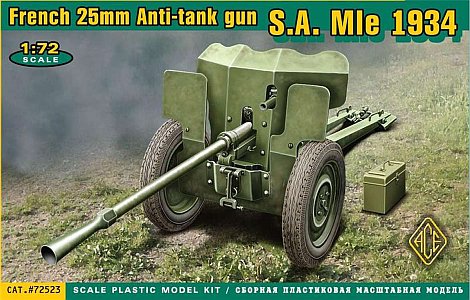|
A short history
The Canon de 25 mm semi-automatique modèle 1934 was designed to replace the ineffective anti-tank guns used during World War One. But as events were to prove,
it too was found to be as inadequate as its predecessors. Its small calibre was insufficient to penetrate most tank armour, thus relegating its use to engagements with
lighter armoured cars and soft skinned vehicles. On top of that, its light weight made it vulnerable to travel damage, especially when being towed. This weakness led
the British Expeditionary Force to employ them as portee guns, where they were loaded onto truck beds for transportation.
Captured examples were designated 2.5cm Pak 112(f) by the Germans. Their front line use was limited with them eventually being primarily used for training
or in static coastal defences.
The kit
This is your typical short run Ace offering. Molding is crude. Flash was non-existent but there were seams on practically every part. Sink marks marred the face of the
outer splinter shield. This is a common occurrence with Ace gun shields possessing a lot of molded on detail. All the parts, 22 in total, are moulded in a light grey styrene like
plastic spread over a single sprue. Instructions cover four pages. Three camouflage schemes are described using black & white artwork. There are no decals.
Suggested camouflage options are for: a three colour green & brown gun in French service, May 1940; a whitewash over panzer grey gun in Wehrmacht service, December 1941;
and a bronze green gun in British service, May 1940.
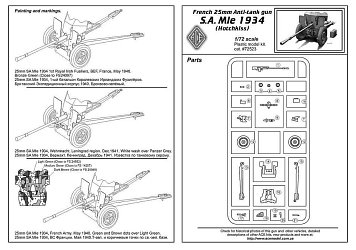
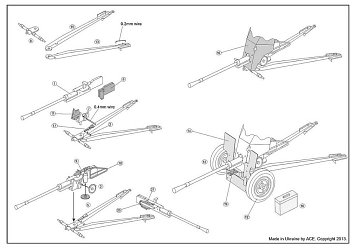
The build
There is but a single build option for the gun in firing position. The instructions were quite clear which is not surprising considering the minuscule parts count. So,
outside of scraping and sanding off the multitude of seams and repairing the sink marks, construction was quite straight forward.
Things I changed or fixed were:
- Replaced the wheel lug nuts with punched plastic disks. The kit's versions were not all identical with regards to size, plus one nut was completely absent.
- After gluing the breech together one is left with an indistinct depression. This was refined with some drilling and filing.
- Replaced the indifferent aiming wheels with a pair from the spares box.
- Various small disks punched from plastic sheet were added to represent missing nuts on the gun's body.
- Replaced the locking bar between the carriage legs (see below).
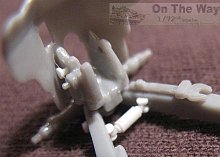
- Performed extensive repairs on both splinter shields. All of the molded on detail was removed, sink marks filled and the faces sanded smooth, then new detail was added using
punched disks and pieces if plastic channel and strip (see below).
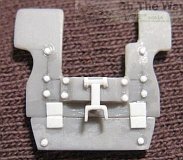
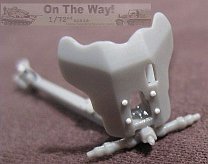
- Thinned the gunner's guard, (part 2), was replaced with bent copper wire. The kit part wasn't that bad, but it lacks the slight bend on its top half present on the real
item (see below).

- The axle is too long which places the wheels too far from the edges of the shield when they are raised into the firing position. I shortened the axle
as much as I could to get the wheels closer to the shield. Visit reference [2] to get a good view of the relative position of wheels to shield.
- Drilled out the flash suppressor, and both ends of the sighting tube
- Added wire grab handles to the trail legs as per the instructions. also added the missing loops found directly behind the handles.

Wishing to represent a German beute gun, my model was painted overall panzer grey. Weathering was kept to a bare minimum in an attempt to replicate the
clean appearance seen on many of the guns in the references listed below.
Another review of this kit by Dan Taylor can be seen here
Conclusion
It's great that Ace offers some off beat subjects you'll never see from the main stream manufacturers. I've always liked the excellent artwork Ace provides on their
box tops. Alas, most everything else inside the box usually isn't up to the same standard. This is a rough kit with poor fit. Detail is decent enough, though it
still takes quite a bit of effort to get it anywhere close to display quality. If only Ace could produce some better looking wheels for this kit
(as well for many other guns in their catalogue) the end result would be markedly improved.
What we need now is for Ace to employ their new 3D processes to revisit this kit (as well as others they have released using their older limited run technology)
to bring it up to their much improved current manufacturing standards. This they most likely will not do, which is a shame.
References
[1] WW2 Fact Files: Anti-Tank Weapons, Peter Chamberlain & Tony Gander, MacDonald & Janes, 1974 ISBN: 0 35608 065 X
[2] Wydawnictwo Militaria 258: Panzerabwehr Artillerie, Maxim Kolomiets, Wydawnictwo Militaria, 2006 ISBN: 83-7219-258-8
[3] Wydawnictwo Militaria 392: Panzerabwehr Artillerie, Maxim Kolomiets, Wydawnictwo Militaria, 2013 ISBN: 9788372193926 (a slightly modified reprint of [5])
[4] toadmanstankpictures.com (walkaround)
[5] questmasters.us (walkaround)
[6] Ace Model (manufacturer's page for this item)
[7] wikipedia
[8] axishistory (thread for 2.5cm Pak 113(f) also containing
photos for the 2.5cm Pak 112(f))
Review sample received from an independent third party donor.
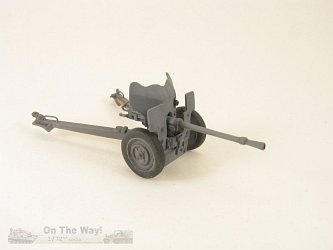
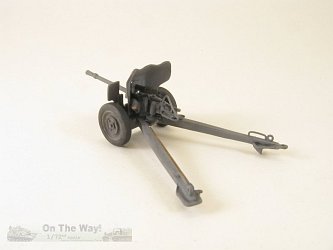
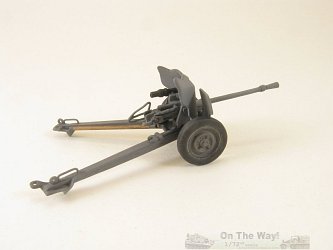
Ace products are available at

|
